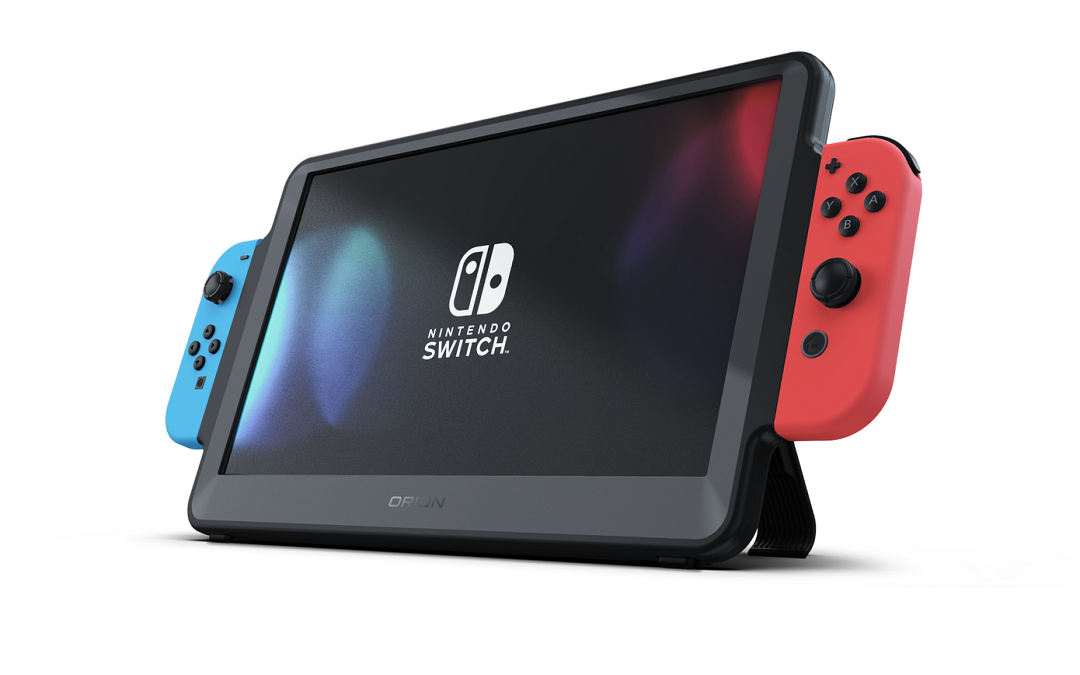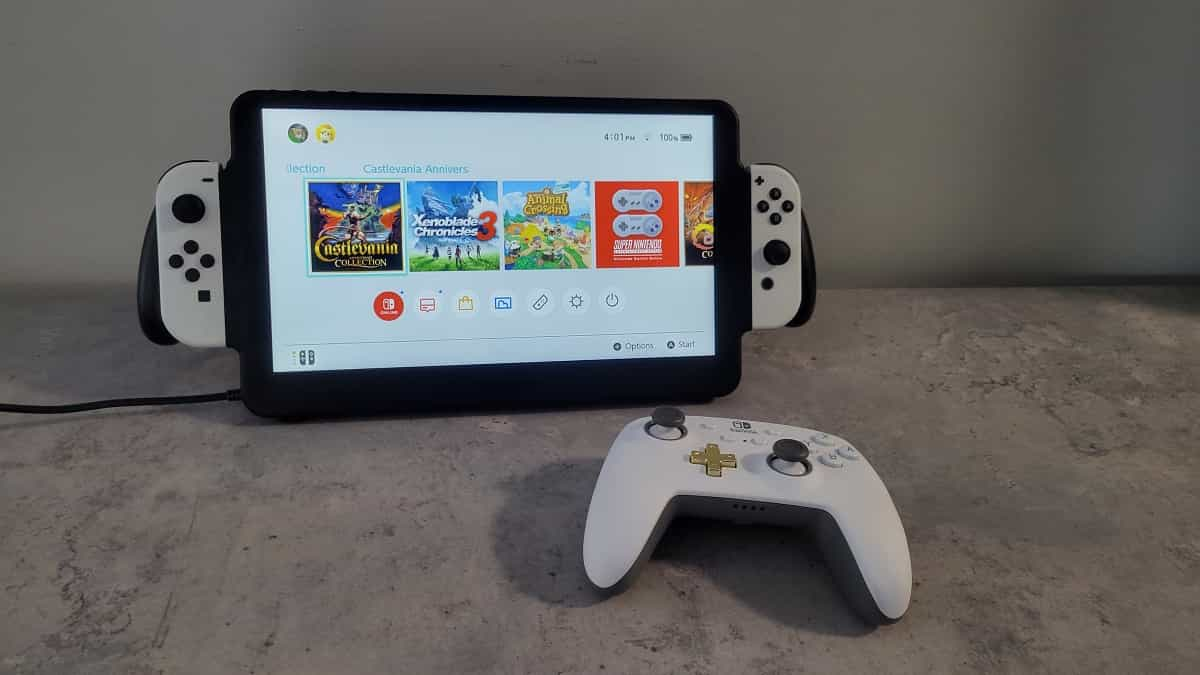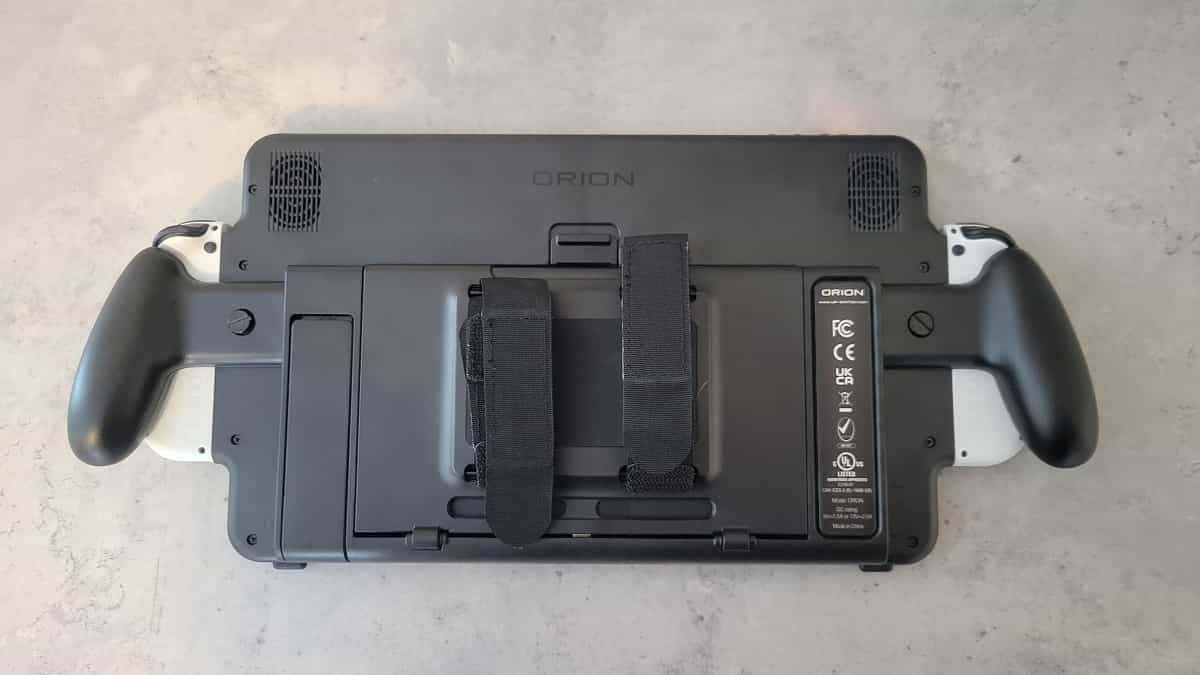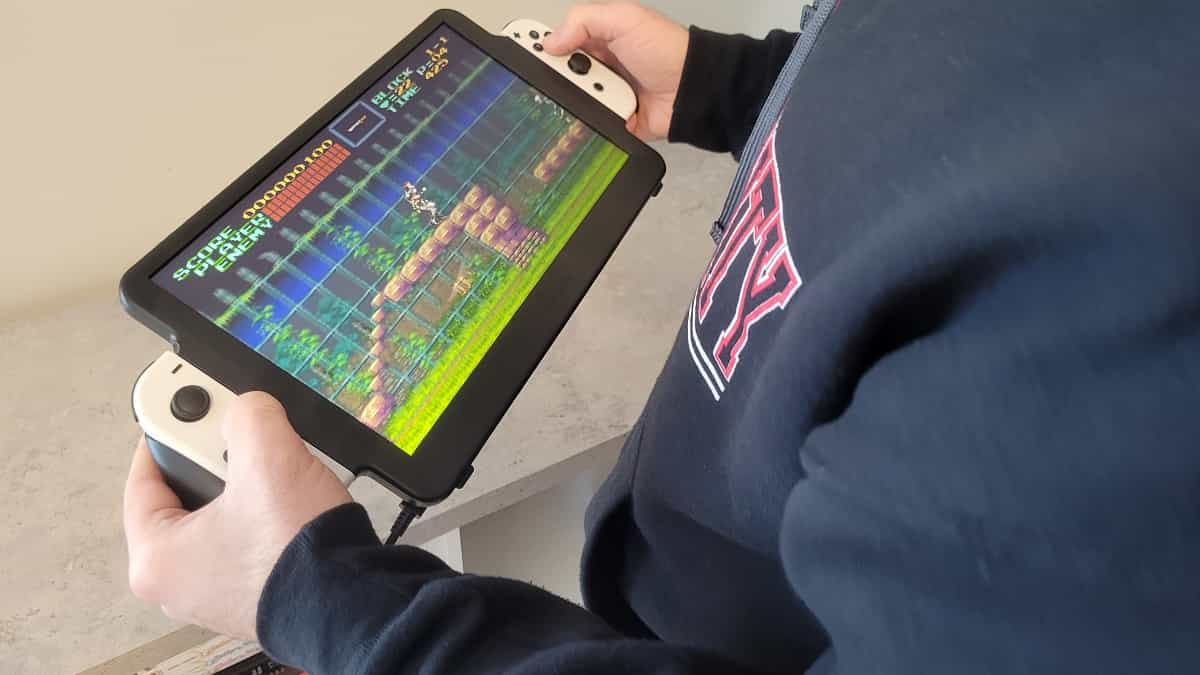One thing I adore about the Nintendo Switch is its portability. Taking the system and a great catalog of games anywhere is a big selling point. But sometimes I wish it had a bigger screen, and I imagine I’m not the only Switch owner to think that.
Despite each Switch model having a relatively large viewing area, eye strain can become an issue when the system’s undocked. For folks that suffer from astigmatism like me, squinting can hamper longer play sessions. It’s difficult at best to play something like Hyper Parasite – or anything with small text and/or assets – away from the TV.
Up-Switch’s Orion portable monitor looks to give Switch owners a bigger option while playing in handheld mode. At first glance, the 11.6-inch display looks formidable in size and scope, providing a decent display upgrade. (Disclosure: There are other portable screens on the market compatible with the Switch that are larger, but I’ve not used or reviewed them).
Retailing for a whopping $249.99 — $50 less than the base Switch, $100 less than the OLED, and $50 more than the Lite — the Orion is a pricey prospect, especially as a peripheral primarily marketed as an accessory, not a necessity. To be fair to that price point, the screen is also compatible with Xbox and PlayStation platforms, as well as phones, tablets, and computers, so there are multiple use cases at play here. Regardless, such a steep investment will likely be off-putting to some.
Out of the box, the Orion comes with a plush drawstring carrying sleeve, which will protect the screen from superficial scratches and scuffs when not in use. Of course, that won’t protect the screen if banged against hard objects, so you may want to invest in something more durable if you plan on taking it on the road or moving around your living space a lot.
There’s the 11.6-inch anti-glare IPS screen itself, which is a large, if understated affair, with a matte black plastic border and Joy-Con rails on either side. In addition, there are two ergonomic grips in which you can insert the JoyCons if the screen’s built-in slots don’t provide the right feel. I found that the grips better displaced the weight of the screen and Switch combo and added more space between my wrists and the power port on the left side.
There are several small buttons – likewise styled after the Switch’s too-small control buttons – across the top for power, switching inputs, and navigating menus and/or raising or lowering the volume and/or raising or lowering the brightness. Confusing? Yeah.
I write it that way because that sentence is about as puzzling as the two multi-function buttons to the right of the power button. In the OSD, they move between options as you’d expect (nothing special there), but out of it, they’ll sometimes raise and lower the screen’s brightness, while other times, they’ll raise and lower the volume. This happened to me both in and out of games. It’s frustrating not knowing which you’ll get, and there seemed to be no rhyme or reason to which function worked when.
On the back of the screen, there are two small speakers, one in the top right and one in the top left, both of which produce decent, if tinny, sound. Beneath those, there’s a sturdy compartment with a locking mechanism that houses the Switch itself, which connects to a USB-C port just as it does in the Switch dock. On the right side, you’ll find a kickstand for tabletop mode and a 3.5mm headphone jack near that. On the left side are the screen’s HDMI-in and power ports.
One of the most important things to know about the Orion is that it doesn’t come with its own power supply, nor is a branded Up-Switch option available separately. Instead, you’ll need to rely on the Switch’s compatible power supply, buy a secondary Switch/third-party power supply, or purchase a compatible USB battery pack, which can be attached to the back of the screen with the provided Velcro straps. Further, that latter option is the only way to be completely untethered and mobile with the Orion; otherwise, you’ll always be wired to a socket.
Problematically, the power port is too close to the left Joy-Con with the ergonomic grips detached. The placement makes it very easy to hit the connection with your palm accidentally. Consequently, you’ll likely stress the wire, the plug, and the port, possibly damaging them over time. The ergonomic grips help a bit, but it’s still a precarious placement.
What’s more, I didn’t find the battery pack option ideal for even moderately-long play sessions, though that’s likely a symptom of my puny battery back. My PNY 10,400 mAh power supply gave me roughly 2 hours of playtime at 100% charge before cutting the screen off mid-session; once the power is cut, the screen turns off immediately, though your Switch won’t. So opt for something a bit more powerful – in the 40,000 mAh range or so – if you’re hoping to remain untethered more often than not.
No matter what power option you choose, all power the screen and charge the Switch simultaneously, perhaps a double-edged sword on the battery pack front.
The Orion’s IPS screen outputs at 1366×768, and generally, things look decent, if a bit washed out. Switch OLED owners will notice the most significant disparity in visual quality across the board; colors just aren’t as crisp, and more brightness can compromise the overall picture fidelity, all things being equal.
That’s not to mention the downgrade you’ll get if connecting the Up-Switch to a PS5 or Xbox Series X|S. It’s nice to have a secondary screen if the TV’s in use, but the sacrifice in quality isn’t always worth it depending on the title. To be fair, I didn’t expect the screen to reproduce OLED colors or 4K HDR graphics, but something at a slightly higher resolution and capable of higher contrast and sharper visuals would up the value.
The onboard OSD provides a few brightness, contrast, and picture mode presets, and there are options to customize the levels as close to your liking as you can. Still, those choices are limited and don’t provide wide-ranging options that drastically alter the initial quality. On top of that, the OSD is cumbersome to navigate.
The navigation buttons are unintuitive, leading to pesky frustrations anytime you want to make adjustments. After two months of use, I still make mistakes, often moving through the menus backward or even closing the OSD altogether.
Up-Switch Orion Review — The Bottom Line
Pros
- Bigger screen minimizes squinting and eye strain.
- Cuts down on glare, especially over the Switch OLED’s screen.
- Nice upgrade for the Switch’s tabletop capabilities.
- Removable ergonomic grips displace screen and Switch weight well.
- Works with PC, mobile devices, and PlayStation and Xbox platforms.
Cons
- Outputs at 1366×768 – just barely HD.
- Produces washed-out colors with few OSD options.
- Screen only works while plugged in or with battery pack.
- Doesn’t come with its own power supply or battery pack.
- Middling speakers feel like a downgrade over the stock Switch speakers.
Despite how much I enjoy playing the Switch on a larger screen, especially in tabletop mode with a Pro controller, it’s hard to outright recommend the Orion to the average player.
Outside of gaining a few inches of screen space, a sturdier kickstand, and more protection for the console undocked, there isn’t a whole lot of improvement elsewhere for an additional $249.99. And while the Orion is technically portable, it tries incredibly hard not to be, ultimately undermining its primary selling point.
[Note: Up-Switch provided the Orion hardware used for this review. Featured image via Up-Switch.]













Published: Dec 20, 2022 1:40 PM UTC